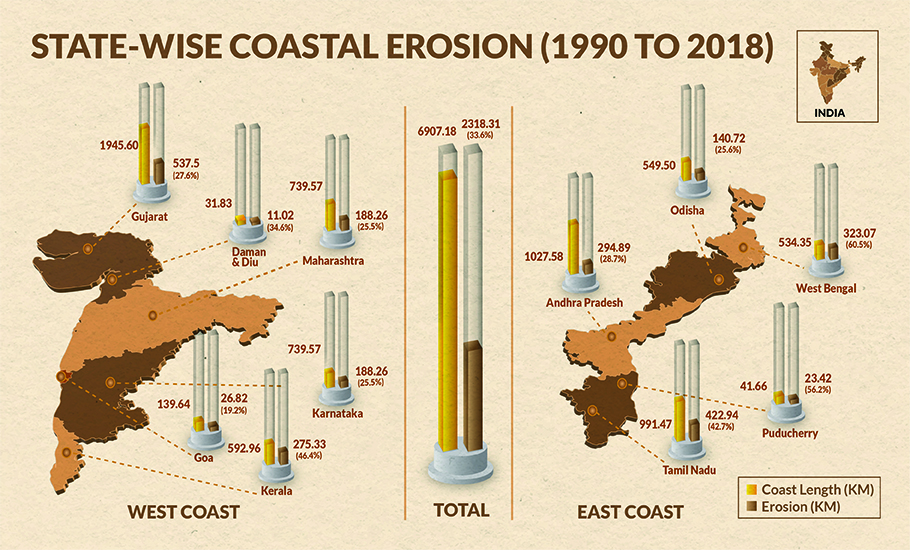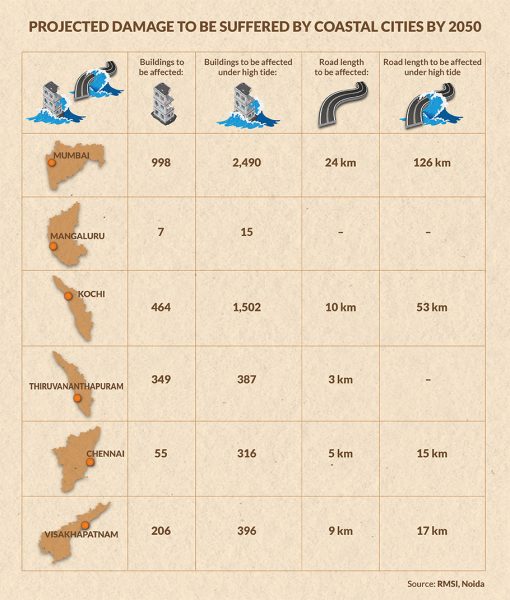
Land erosion has impacted one-third of India's coastline in 3 decades: Govt data
Replying to a Lok Sabha query, the Science Ministry acknowledged the threat posed by sea-level rise, which it attributed to climate change, fossil fuel use and emissions of heat-trapping gases

Rising sea levels on the east and west coasts of India are resulting in coastal erosion, threatening the livelihoods of people dependent on the sea and allied businesses. Sea-level rise also poses an “existential threat” for some small islands. People living along coasts face longer droughts, deeper floods, fish spoiled by ocean heating and fresh water contaminated by encroaching seas. Storms raze homes, schools, hospitals, shops and crops.
Responding to a question posed by BJP Member of Parliament Aparajita Sarangi in the Lok Sabha, Minister of Science, Technology and Earth Sciences, Jitendra Singh, admitted that the threat posed by climate change and the subsequent rise in sea levels is real.
Quoting remote sensing data and GIS maps provided by the National Centre for Coastal Research (NCCR), Chennai, for the period 1990 to 2018, the Science Ministry noted that about 34% of the coastline is under varying degree of erosion, 26% is of accreting nature and the remaining 40% is in a stable state.

The ministry, in reply to Sarangi, acknowledged the threat posed by sea level rise, which it attributes to climate change, exacerbated by burning of fossil fuels and emissions of heat-trapping gases in to the atmosphere.
The latest Intergovernmental Panel on Climate Change (IPCC) report reveals that the global mean sea level is expected to rise by 0.28-0.55 m by the year 2100 under the very low greenhouse emission scenario (SSP1-1.9), 0.44-0.76 m under the intermediate emission scenario (SSP2-4.5) and 0.98-1.88 under the very high emission scenario (SSP5-8.5), said Singh in his Lok Sabha reply.
Impact on small islands
Small islands are already reporting losses and damages, particularly from tropical cyclones and increases in sea-level rise. Despite the loss of human life and economic damage the methods and mechanisms to assess climate-induced losses and damages remain largely undeveloped for small islands. Further, there are no robust methodologies to infer attribution and such assessments are limited.
Extent of damages India’s coastal cities may suffer by 2050
The newest Intergovernmental Panel on Climate Change (IPCC) report says India is one of the most vulnerable countries. Noida-based IT consultation company RMSI studied the IPCC report and related publications to understand the extent to which coastal Indian cities are likely to be affected.
It has made projections for each city considering two scenarios – inundation due to sea-level rise, and areas affected during high tides.

Measures planned to mitigate effects of coastal erosion
In the Lok Sabha, Sarangi asked to know whether the Centre has formulated any plans to rehabilitate people from low-lying coastal areas, who may be adversely impacted due to rising sea levels.
Singh replied that the Finance Commission has recommended the creation of the National Disaster Risk Management Fund (NDRMF) and State Disaster Risk Management Fund (SDRMF). “All efforts will be aimed at generating Mitigation Fund and Response Fund at the national and state levels for the award period from 2021-22 to 2022-26,” he said.


